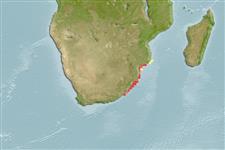Environment: milieu / climate zone / depth range / distribution range
Ekologi
laut berasosiasi dengan karang; nir-ruaya; kisaran kedalaman 10 - 100 m (Ref. 5222), usually 30 - 80 m (Ref. 89707). Subtropical; 23°S - 35°S, 29°E - 38°E (Ref. 5222)
Western Indian Ocean: Quissico, Mozambique to East London, South Africa.
Size / Weight / umur
Maturity: Lm ? range ? - ? cm
Max length : 100.0 cm TL jantan/; (Ref. 5222); Berat maksimum terpublikasi: 13.0 kg (Ref. 4787)
Duri punggung (Keseluruhan (total)): 11; duri punggung lunak (Keseluruhan (total)): 14; Duri dubur 3; Sirip dubur lunak: 8. Distinguished by the following characteristics: head, body, dorsal and caudal fins pale brown, with numerous dark brown spots; ventral parts of head and body lacking spots; juveniles, many of the spots merge to form double spots; prominent dark brown streak along the upper edge of maxillary groove; margin of interspinous dorsal fin membranes yellow or gold; soft dorsal and anal fin dusky distally, with prominent white edge; upper and lower edges of posterior part of caudal fin white edged; pectoral fins yellowish or reddish orange; body depth less than head length, 2.6-3.0 times in SL; head length 2.3-2.5 times in SL; angular preopercle, 2-3 enlarged serrae at the angle; upper edge of operculum straight or convex; naked maxilla, without a step on ventral edge; caudal fin truncate, corners rounded in adults, posterior edge convex in juveniles; lateral body scales ctenoid, with few auxiliary scales in adults (Ref. 089707).
Found over rocks and corals at depths of at least 100 m. Feeds mainly on benthic invertebrates, also on fishes and squids (Ref. 4787, 5213).
Life cycle and mating behavior
Kematangan | Reproduksi, perkembang biakan | Pemijahan | telur-telur | Fecundity | Larva
Heemstra, P.C. and J.E. Randall, 1993. FAO Species Catalogue. Vol. 16. Groupers of the world (family Serranidae, subfamily Epinephelinae). An annotated and illustrated catalogue of the grouper, rockcod, hind, coral grouper and lyretail species known to date. Rome: FAO. FAO Fish. Synop. 125(16):382 p. (Ref. 5222)
Status IUCN Red List (Ref. 130435)
ancaman kepada manusia
Harmless
penggunaan manusia
Perikanan: perikanan swasembada
informasi lanjut
Nama-nama umumSinonim (persamaan)metabolismePemangsaEkotoksikologiReproduksi, perkembang biakanKematanganPemijahanSpawning aggregationFecunditytelur-telurpekembangan telor
AcuanBudidaya airprofil budidaya airStrainGenetikaElectrophoresesDiturunkanPenyakit-penyakitPengolahanNutrientsMass conversion
mitraGambarStamps, Coins Misc.Suara-suaraCiguateraKecepatanTipe renangArea insangOtolithsOtakPenglihatan / visi
Alat, peralatan
laporan khas
muat turun XML
Sumber internet
Estimates based on models
Preferred temperature (Ref.
123201): 21.9 - 25.4, mean 24.5 °C (based on 22 cells).
Phylogenetic diversity index (Ref.
82804): PD
50 = 0.5000 [Uniqueness, from 0.5 = low to 2.0 = high].
Bayesian length-weight: a=0.01259 (0.00654 - 0.02422), b=3.04 (2.88 - 3.20), in cm total length, based on LWR estimates for this species & Genus-body shape (Ref.
93245).
Trophic level (Ref.
69278): 4.2 ±0.53 se; based on food items.
Daya lenting (Ref.
120179): Rendah, Waktu penggandaan populasi minimum 4.5 - 14 tahun (Preliminary K or Fecundity.).
Fishing Vulnerability (Ref.
59153): High vulnerability (60 of 100).
